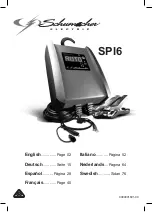
3
Specifications:
Input voltage: 220–240 V AC, 50 Hz
Output current: 4 A max.
Charging voltage: 7.3 V/14.4 V/14.7 V
Charging current: 0.8 A ± 10 %/3.0 A ± 10 %/4.0 A ± 10 %
Types of battery: All types of 12 V lead-acid batteries
(liquid electrolyte - WET, maintenance free MF MF, Ca/
Ca, AGM and Jelly).
Battery capacity: 6 V: 1.2 Ah to 14 Ah; 12 V: 1.2 Ah to
120 Ah
Type of charger: 7 stepper, fully automatic charging cycle
Power consumption from the network: 600 mA (at full
charging current)
Discharging due to backflow *: < 1 mA (< 1 Ah per month)
Ripple **: < 5 %
Efficiency: > 80 %
Stand-by mode: < 1 W
Trickle charge current: 50–150 mA
Voltage level for evaluating wrong or improper battery: <
3.7 V or > 15 V
Protection against short circuit, overload, overheating and
polarity reversal.
Automatic charge termination
Trickle mode
Charging cable: 1.8 m – terminals (+ red - black)
Power cable: 1.8 m
Protection: IP65
Ambient temperature: 0 °C – 40 °C (at high temperatures
the output power is automatically reduced)
Dimensions: 194 × 64.3 × 47 mm (L × W × H)
Weight: 526 g
*) Discharge by backflow current is due to the current flowing
through the attached charger when it is disconnected from
power. Charger EMOS type EE04A has a very small reverse
current, which corresponds to < 1 Ah per month (1 mA/h).
**) The quality of the charging voltage and current is very
important. High ripple current causes heating of the battery
and accelerates the aging of the positive electrode. High ri-
pple voltage can also interfere with other devices connected
to the battery. Charger EMOS EE04A provides voltage and
current of high-quality, with low ripple effect.
Charger EMOS type EE04A is a 7-step fully automatic
charger and recharger of 6 V/12 V lead-acid batteries with
charging mode switching. It is a versatile charger that has the
charging modes for small and large batteries with a capacity
of 1.2 Ah – 120 Ah – e.g. for cars, caravans, boats, motor-
cycles, quads, jet skis but also as a backup power source.
Batteries may be of different types, such as WET (wet with
the liquid electrolyte), JELLY (with jelly electrolyte absorbed
in the separators), AGM (absorbent glass separator).
The auto battery charger recharges accumulators even in
cold conditions. Using cutting edge technology allows rechar-
ging batteries to nearly 100 % of their original capacity. It
can easily recover sulfate batteries. It diagnoses and charges
depleted batteries. It allows “droplet” charging and “trickle”
charging, thereby increasing battery life and ensuring its
excellent performance. The charger is characterized by a
low reverse current consumption.
Operating Instructions
Carefully read the manual and safety information about
the vehicle to determine the correct procedure to charge
the battery. Modern vehicles are equipped with sensitive
electronic components that can be damaged by incorrect
procedure.
Description of functions and icons (see Fig. 1)
Icon
Description
Meaning
LED
colour
1
MODE button
Recharge mode
switch
-
2
Power supply
indicator
Stand-By
red LED
3
Recharge indicator
Recharge
red LED
4
Fully charged
accumulator
indicator
Fully charged
accumulator
green
LED
5
Fault indicator
Pole switch
red LED
6
Programme for
small accumulators Charge 6 V 0.8 A red LED
7
Programme for
small accumulators
12 V “motorcycle”
Charge 12 V
0.8 A
red LED
8
Programme
for normal
accumulator 12 V
Charge 12 V
4.0 A
red LED
9
Programme for cold
weather
Charge 12 V
4.0 A (cold
weather)
red LED
-
Accumulator
voltage < 3.7 V or
> 15 V
Faulty
or unsuitable
accumulator
4 red
LED
blinking
Charging a lead-acid battery
1. Make sure that you are going to charge 6 V or 12 V
battery. Do not charge batteries with different voltage
rating than 6 V or 12 V.
2. Disconnect all appliances from the battery. If the battery
in the vehicle, turn off the ignition and all appliances.
Then disconnect the cables, disconnect the negative
terminal (-) black cable, then disconnect the positive
terminal (+) red cable.
3. Clean the terminals on the battery charging.
4. Connect the charger to the battery. Note the correct
polarity (+ is red and - is black). First connect the red (+)
terminal to the positive terminal of the battery (+). Then
connect the black (-) terminal to the negative terminal
of the battery (-).
5. Connect the charger to the socket (220–240 V AC, 50
Hz). Power indicator (icon 2) lights up red. If the cables
are not connected correctly, the red LED fault indicator
(reversal) – icon 5 – will light up. Protection against
reverse polarity ensures that there is no damage to the
battery or charger. In case the faulty battery there will
simultaneously blink red LED icons 6, 7, 8 and 9.
6. Press the MODE button to select the desired charging
programme. Individual charging programmes are descri-
bed in the next chapter.
7. Battery is fully charged when the green LED 4 lights
up. At the same time the icon of the selected charging
programme will light up.
8. When finished charging, disconnect the charger from the
socket. Then disconnect the terminal from the negative
pole. Finally, remove the terminal from the positive pole.




































